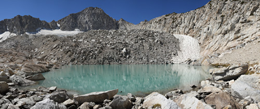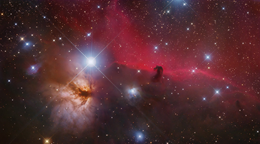
|
|
|
Featured Artist: Chuck VaughnChuck Vaughn's photography goes to extremes. On one hand, he photographs a tiny sliver of the night sky to capture the mystery and beauty of nebulas so faint they are all but invisible through the telescope that serves as his lens.On the other hand, he makes panoramas of the rugged Yosemite country that extend across an 180-degree field of view. A childhood interest in science morphed into photography decades later, when the 1986 passing of Halley's comet lured him into astrophotography. This was a beginning, and it took many months before he managed to capture the brilliant images of nebulas and galaxies on his website: http://aa6g.org. (The unusual domain name is Vaughn's amateur radio call sign, by the way.) Of course, at that time, he shot film, with a Celestron C8 Schmidt Cassegrain. He quickly learned that astrophotography, at the level he wanted to practice it, was a complex endeavor with lots of (literally) moving parts and a steep learning curve. He switched to digital in 2005, with a Canon 20Da, a standard Canon DSLR modified for astrophotography, and a few years later began using an Orion StarShoot Pro, a CCD camera made for deep space imaging. But going digital did little to simplify the process. "The only difference is the digital capture, so you don't have to scan film. But all the processes you do are very similar," Vaughn says. First there are the mechanical parts of the process to master. You have to get your telescope and mount aligned and prepared to precisely track the target through exposures on film that often run to three hours. (Digital exposures may total the same amount of time, but are built over numerous, shorter "sub-exposures" typically in the ten minute range.) You have to assure the internal stability of the telescope itself—the big ones tend to flex—and make sure the field of view is flat. You have to pinpoint your location on Earth, pinpoint the object you want to photograph and aim your telescope accurately. Capturing the image is only the beginning. Then you have to calibrate and align all your sub-exposures by applying dark frames to reduce noise, then apply flat field frames to correct vignetting, precisely align the frames, and combine them into a final image, "which is almost always very dark," Vaughn says. "You have just a tiny bit of data way down on the left side of the histogram. Then you have to stretch that with levels and curves in Photoshop or with special programs, and use noise reduction." He uses Noise Ninja, Vaughn explains. "And you may still have to correct a gradient across the field, because one side will be lighter. Then you have to do white balance, because the sensor response isn't the same in all three (color) channels and you may sharpen portions, or change the saturation in some area and use other techniques to bring out faint details. It's a huge amount of stuff," he adds. A glimpse of the process makes the images that much more remarkable. Additionally, consider that Vaughn shoots from his Northern California home with an "amateur" telescope and that his subjects require a truly dark, cloudless sky, and his many superb images seem nothing short of extraordinary. "It helps that I live in a place where I can go out in my back yard and do it," he adds. His location, some two hours from the entrance of Yosemite National Park, also proves convenient for the panoramas he shoots, as well. Some three or four years ago when a fellow astrophotographer suggested doing some hiking, Vaughn readily agreed. Naturally enough, he carried a camera. Not only is the scale of his panoramas worlds away from his astrophotography, so is the process. "We hike to someplace with a good view, set up the cameras, and take a lot of pictures with different focal lengths. Sometimes the camera is on a tripod, sometimes I hand-hold it. Then I bring lots of images home and let Photoshop put them together. Once in a while, I get something I really like and I have it printed," he says. One example is a 12-ft. by 22-in., 180-degree panorama, printed by AutumnColor in five segments, that Vaughn assembled on the wall using five clip frames. Another is a 24-in by 60-in. single print that has so much detail, "you have to get six inches away to see it all." Vaughn is a long-time AutumnColor customer who finds the service and quality unrivaled. "Recently, I tried someone else," he says, "but I wasn't happy. The color wasn't spot-on, as it always is with Mark." "The last print Mark made was a panorama with a lot of sky and water and a lot of different shades of granite. If the granite has a little magenta in it, for example, you notice that it is off right away. When I get prints from AutumnColor, the granite always looks exactly like it does on my monitor. They look perfect," he adds. |
All photos this page © Chuck Vaughn

|

| |||
Copyright ©  AutumnColor Digital Imaging AutumnColor Digital Imaging | | 70 Webster Street 70 Webster Street | | Worcester, MA 01603 Worcester, MA 01603 | | Toll Free: 800-533-5050 Toll Free: 800-533-5050 | | Fax: 508-757-2216 Fax: 508-757-2216
|
|||



